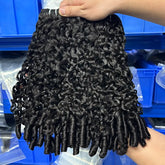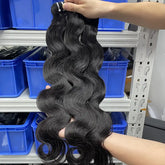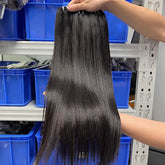How to Build a Website to Sell Hair Extensions

Welcome to our comprehensive guide on how to build a website to sell hair extensions. In today’s digital landscape, a strong online presence is a game-changer for businesses in the beauty industry—especially for those specializing in hair extensions. Whether you’re a salon owner ready to scale your services, a wholesaler targeting more retailers, or a retailer eager to break into the online market, this tutorial is your roadmap to success.
This guide will show you how to build a website to sell hair extensions in 10 actionable steps. We’ll cover everything from securing the perfect domain name to launching a site that drives sales, all tailored for B2B professionals in the black hair and wig sector. Let’s dive in and turn your vision into a thriving online store!
This Guide Will Show You How to Build a Website to Sell Hair Extensions in 10 Steps
Step 1: Choose a Memorable Domain Name
Your domain name is your digital storefront—it’s the first impression customers get of your brand. A strong domain name should be memorable, brand-relevant, and optimized for search engines.
For a hair extensions business, weave in keywords like “hair extensions” to boost SEO while keeping it catchy. Pro tip: target your niche could resonate with your B2B audience. Use tools like GoDaddy or Namecheap to check availability. If your top pick is taken, experiment with extensions like .co or .shop. Expect to spend $10–$20 annually to register it.
Tip: Avoid hyphens or numbers—they can confuse customers and dilute your brand.
Step 2: Select a Reliable Web Hosting Service
Your hosting service is the foundation of your website, storing files and ensuring it’s accessible 24/7. For an e-commerce site selling hair extensions, prioritize hosts with e-commerce-friendly features: fast load times, SSL certificates, and scalability.
Options like SiteGround, Bluehost, or WP Engine are great for beginners and offer robust support. Look for at least 99.9% uptime and e-commerce compatibility (e.g., WooCommerce or Shopify integration). Plans typically range from $5–$30/month depending on traffic and storage needs.
Tip: Choose a host with one-click backups—salon owners and wholesalers can’t afford downtime during peak sales seasons!
Step 3: Design a Stunning, User-Friendly Website
A well-designed website keeps visitors browsing and buying. Focus on a clean layout, mobile responsiveness (over 50% of users shop via mobile!), and visuals that scream quality—think high-res images of your hair extensions in action.
Use platforms like Shopify (e-commerce-focused), Wix (drag-and-drop ease), or WordPress with a theme like Astra for flexibility. Match your design to your brand—bold colors for a trendy vibe or sleek neutrals for a professional wholesaler look. Highlight your best sellers on the homepage.
Tip: Add a “Shop by Texture” filter (e.g., kinky, coily, wavy) to cater to the black hair market’s diversity.
Step 4: Add Seamless E-commerce Functionality
To sell hair extensions online, you need a smooth shopping experience. Integrate a shopping cart, product pages with variants (length, color, texture), and a streamlined checkout.
Platforms like Shopify or WooCommerce (for WordPress) simplify this—set up product categories (e.g., “Virgin Hair,” “Bundles”), pricing tiers for B2B bulk orders, and shipping rates. Test the “Add to Cart” flow to ensure it’s intuitive.
Tip: Offer a “Request a Quote” feature for wholesalers—B2B buyers love custom pricing options.
Step 5: Optimize Your Website for SEO
Search engine optimization (SEO) drives free traffic to your site. Start with keyword research—beyond “hair extensions,” target terms like “wholesale hair extensions,” “black hair extensions,” or “salon hair products” using tools like Google Keyword Planner.
Incorporate these keywords into product titles, descriptions, meta tags (e.g., <meta name="description" content="Premium hair extensions for salons and wholesalers">), and URLs. Ensure fast load times and mobile-friendliness—Google prioritizes these for rankings.
Tip: Create a blog page (see Step 6) to rank for long-tail keywords like “best hair extensions for braiding.”
Step 6: Create Compelling, High-Quality Content
Content builds trust and keeps customers coming back. Showcase your hair extensions with detailed product descriptions (e.g., “100% Remy human hair, 20-inch kinky straight”), vibrant photos, and videos (e.g., styling demos).
Launch a blog with posts like “Top Hair Extension Trends for 2025” or “How Salons Can Upsell Extensions.” This not only engages visitors but boosts SEO. Add customer testimonials—B2B buyers trust peer feedback.
Tip: Share care guides (e.g., “How to Maintain Curly Extensions”) as downloadable PDFs to capture emails.
Step 7: Set Up Secure Payment Gateways
A reliable payment system is non-negotiable. Options like PayPal, Stripe, or Square are secure and widely trusted—perfect for B2B transactions. Look for low fees (around 2.9% + $0.30 per sale) and multi-currency support if you’re targeting international wholesalers.
Integrate it via your e-commerce platform and test it with a small transaction. Offer options like bank transfers for bulk orders—salon owners often prefer this.
Tip: Display trust badges (e.g., “Secured by Stripe”) at checkout to ease buyer concerns.
Step 8: Implement Robust Security Measures
Protecting customer data builds credibility—especially for B2B clients handling bulk orders. Install an SSL certificate (your URL should start with https://) for encrypted transactions. Most hosts include this free.
Use strong passwords, enable two-factor authentication, and update plugins regularly. For extra peace of mind, add a firewall via Cloudflare or Sucuri. Back up your site weekly—data loss isn’t an option.
Tip: Highlight your security features (e.g., “Shop with Confidence—SSL Secured”) on your site.
Step 9: Test Your Website Thoroughly
A glitchy site kills sales. Before launch, test everything: click every link, add products to the cart, and complete a checkout. Use tools like Google’s Mobile-Friendly Test to confirm responsiveness and PageSpeed Insights to optimize load times (aim for under 3 seconds).
Ask a colleague or friend in the hair industry to navigate it—fresh eyes spot issues you might miss. Fix any broken elements before going live.
Tip: Simulate a B2B order (e.g., 10 bundles) to ensure bulk purchasing works smoothly.
Step 10: Launch and Promote Your Website
Launch day is here! Share your site via email blasts to your network and post on social media (Instagram and LinkedIn work wonders for B2B). Drive traffic with SEO (from Step 5), paid ads (Google Ads or Facebook), and partnerships with beauty influencers in the black hair space.
Track performance with Google Analytics—monitor traffic, bounce rates, and sales. Offer a launch discount (e.g., “10% off first orders”) to hook early buyers.
Tip: Join hair industry forums or groups (e.g., Black Hair Media) to promote your site organically.
Conclusion
Congrats—you’ve mastered how to build a website to sell hair extensions in 10 steps! You’re now equipped to create a professional, profit-driven online store that connects you with salon owners, wholesalers, and retailers. This is just the beginning—keep refining your site, testing new strategies, and promoting relentlessly to dominate the hair extensions market. Ready to shine? Start building today and watch your business thrive!
In Case You’re Wondering…
Q: Do I need tech skills to build this website?
A: Nope! Tools like Wix or Shopify are beginner-friendly with drag-and-drop interfaces. If you want more control (e.g., WordPress), basic tutorials can get you started.
Q: How long will it take to get my site live?
A: A simple site can be ready in 1–2 weeks with a platform. Custom builds might take 4–6 weeks, especially with B2B features like bulk pricing.
Q: What’s the best way to promote my hair extensions website?
A: Mix SEO (target “hair extensions wholesale”), social media (Instagram Reels of installs), and email campaigns. Partner with black hair influencers or salons for shoutouts.
Q: How do I make my site stand out in the black hair market?
A: Focus on niche needs—offer textures like 4C or kinky curly, showcase black models, and provide B2B perks like tiered pricing or fast shipping.







